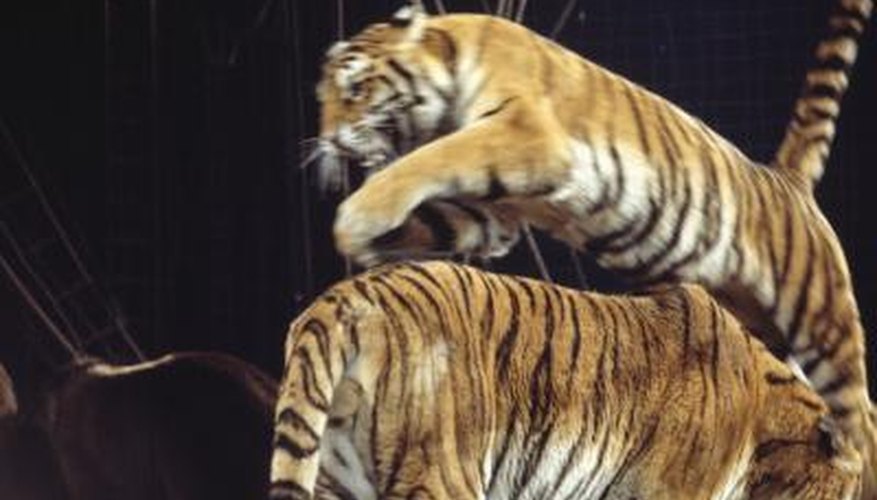Attending a circus event is a rite of passage for many youngsters. Generations of people have brought their children to see wild circus animals. Global awareness of animal rights and wildlife conservation efforts are changing the sentimental feelings the circus once provoked. China has banned animal circuses and Bolivia has banned live animals from travelling circuses. As of 2011, the British government also is working a policy pertaining to wild animals in circuses.
Potential Breeding Program
Circus animals such as tigers and elephants are on the endangered species list. Circus animals bred into captivity increase the species’ odds of survival. Banning circuses from using animals would decrease the number of species in captivity and increase the chance of extinction. However, some circuses won’t allow their animals to breed. Circus demands for wild animals increase the numbers of animals removed from wild. Efforts need to be made to encourage circus owners to breed animals to maintain captive animal populations and reduce the number of wild animals removed from their natural environments.
- Circus animals such as tigers and elephants are on the endangered species list.
- Banning circuses from using animals would decrease the number of species in captivity and increase the chance of extinction.
Circus Animals' Fate
Circus animals age and eventually outgrow their usefulness. Finding suitable homes for former circus animals is difficult. Retired animals must be placed in a zoo, sanctuary or with an individual trained to care for wild animals. Carson and Barnes Circus supports its own herd of retired elephants in Oklahoma. It is illegal to euthanize endangered species for no reason. Circuses must report all endangered species deaths to the U.S. Fish and Wildlife Service. Animal rights activists object to the overwhelming number of animals that have died due to abusive treatment and lack of veterinary care in circuses.
- Circus animals age and eventually outgrow their usefulness.
- Retired animals must be placed in a zoo, sanctuary or with an individual trained to care for wild animals.
Condemning Cultural Traditions
Some cultural traditions are founded upon animal exploitation for entertainment purposes. Bull fighting practices are legal in Spain, Mexico and parts of France. Although bull fighting is extremely cruel, banning bull fighting would affect the bull fighting cultural tradition. Proponents of using animals for entertainment argue that condemning animal related events shows a lack of sensitivity toward cultural traditions. The circus is a cultural tradition in the United States and throughout the world. Restricting animal use in a circus show could be viewed as an infringement on an individual’s right to enjoy animal acts. Differing viewpoints regarding what constitutes animal abuse compounds this issue.
- Some cultural traditions are founded upon animal exploitation for entertainment purposes.
- Restricting animal use in a circus show could be viewed as an infringement on an individual’s right to enjoy animal acts.
Quality of Life
Circuses train wild animals to perform unnatural acts for human amusement. Training techniques involve using whips and other devices to force animals to act. Proponents claim that there is evidence that animals enjoy performing and that they form bond with trainers. Circus animals are forced to live in a cage, travel extensively and exist in an unnatural environment. Proponents view circus animals as an opportunity for children to view and appreciate animals. Opponents argue that animal circus acts are demeaning to animals and do not teach children how to appreciate and respect wild animals.
- Circuses train wild animals to perform unnatural acts for human amusement.
- Opponents argue that animal circus acts are demeaning to animals and do not teach children how to appreciate and respect wild animals.
